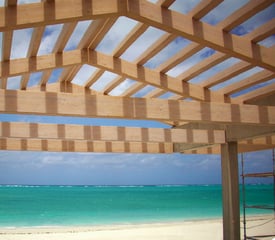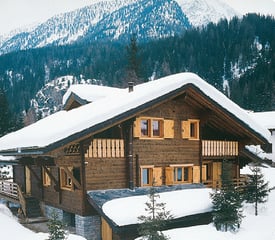
WHAT IS CLIMATIC PROTECTION?
PROTECTION FROM THE SUN AND FROM WATER
Sunlight, rain, hail and other atmospheric agents carry out daily attacks on wood located outdoors. Useful advice for long-lasting protection.




Wood located outdoors is subject to the combined action of sunlight and precipitation both of which transform and wash away the lignin. The wood turns grey and weakens.
The best solution for protecting wood from climatic attack is protective construction. The more the wood is exposed to direct sunlight the more damage it suffers. Design features such broad roof canopies, protect the wood beneath them over time.
Roof canopies are not the only protective system, many precautions can be taken, including some minor ones, to avoid the wood weakening and rotting. One of the main rules to follow during construction is to guard against water becoming trapped, ensuring it can flow away without creating stagnant puddles. No treatment can protect wood from water build-up.
If the necessary action has not been taken during construction to protect wood from UV radiation and rain, or if this has proved impossible, protective varnishing systems can be used to ensure that outdoor wood maintains its beauty, also notably lengthening its lifetime.
Protection from UV rays.
South and west-facing areas are particularly exposed to powerful sunlight. UV radiation, one of the components of sunlight, affect wood and in particular the lignin within it, transforming it from a solid, cohesive material to a water-soluble one. The permanent combined action of sunlight and rain therefore carries away the lignin over time, leading the wood to turn grey and its fibres lift. To limit the effects of this action, physical UV filters need to be used. Substances that absorb UV and capture free radicals are often used to assist this protection, but the true filter is in the pigmentation of the colour selected. The degree of protection depends on the amount of pigment.
- Non-pigmented varnishes (transparent or colourless) leave the colour and structure of the wood on show, but provide no UV protection. They are not recommended for wood directly exposed to climatic agents.
- Pigmented varnishes (partially transparent) – it is still possible to see the wood grain, protection is good but not complete. Darker tones provide more protection than lighter ones.
- Covering varnishes – provide a complete shield against UV rays.
Protection from IR rays.
Infrared rays heat up the wood and may cause splits. To limit this effect, it is enough to opt for a lighter-toned finish. The darker the colour, the more the surface will heat up.
The best solution for protection from the sun’s rays is to choose a suitable system with medium colouration to provide good UV protection without overheating the surface of the wood.
Protection from rain and damp.
Damp provides fertile ground for the proliferation of bacteria and it also causes the wood to swell and shrink. If the wooden elements must not undergo changes (dimensional stability), it is important to use coats of varnish with a high content of binders and that are thick enough to completely close the pores of the wood. To lengthen the life of other structures and reduce their absorption of damp, medium-thickness coatings can be chosen that do not close the pores of the wood to enable normal moisture/air exchange.
Amonn offer a wide range of solutions, both water and solvent-based, for all different needs.

